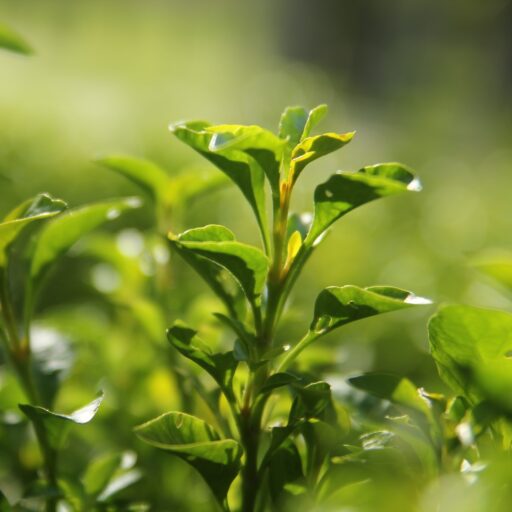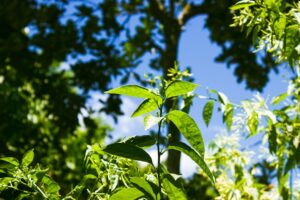Support our educational content for free when you purchase through links on our site. Learn more
🌿 Grow Your Own Tea Garden: 10+ Tea Herbs to Plant at Home [2024]
Imagine this: You’re sipping a fragrant, refreshing cup of tea, knowing that every leaf was carefully nurtured and harvested by your own hands. This isn’t just a dream; it’s a reality for more and more people who are discovering the joys and benefits of growing their own tea gardens.
We’ve been growing tea here at Growing Teas™ for years, and we’ve learned a thing or two about getting the most out of your homegrown tea experience. You can grow tea at home too – without needing a vast garden or special expertise. In this comprehensive guide, we’ll delve into everything you need to know, from choosing the perfect tea herbs to harvesting and enjoying your own unique blends.
Ready to start growing your own tea garden? Let’s dive in! 🍃
Quick Answer:
- You can grow your own tea garden with ease! Start with simple, hardy herbs like mint, lemon balm, and chamomile.
- Consider growing true tea plants (Camellia sinensis), but be prepared for a longer commitment and a bit more care.
- Get your hands dirty! The rewarding experience of growing your own tea is a journey of discovery, creativity, and pure relaxation.
👉 CHECK PRICE on:
- Seed Starting Supplies: Amazon | Walmart | Gardeners Supply Co.
- Organic Fertilizers: Amazon | Walmart
Table of Contents
- Quick Tips and Facts
Quick Tips and Facts - The History of Tea and Its Journey to Your Backyard
The History of Tea and Its Journey to Your Backyard - Tea Herbs to Grow at Home: A Beginner’s Guide
Tea Herbs to Grow at Home: A Beginner’s Guide - Other Favorites: Beyond the Basics
Other Favorites: Beyond the Basics - Planting Tips for Success: From Seed to Cup
Planting Tips for Success: From Seed to Cup - Blending Your Own Teas and Beyond: Unleash Your Inner Alchemist
Blending Your Own Teas and Beyond: Unleash Your Inner Alchemist - From Our Shop: Everything You Need to Grow Your Own Tea Garden
From Our Shop: Everything You Need to Grow Your Own Tea Garden - Harvesting Your Tea: A Guide to Picking the Perfect Leaves
Harvesting Your Tea: A Guide to Picking the Perfect Leaves - Drying and Processing Your Tea: From Garden to Cup
Drying and Processing Your Tea: From Garden to Cup - Troubleshooting: Common Problems and Solutions
Troubleshooting: Common Problems and Solutions - The Joy of Homegrown Tea: A Personal Reflection
The Joy of Homegrown Tea: A Personal Reflection - Conclusion
Conclusion - Recommended Links
Recommended Links - FAQ
FAQ - Reference Links
Reference Links
Quick Tips and Facts
🌱 Did you know? You can grow tea right in your backyard!
It’s easier than you might think, and nothing beats the satisfaction (and flavor!) of homegrown tea. 🍵
Here are some quick tips to get you started:
- Start simple: Begin with easy-to-grow herbs like mint, lemon balm, or chamomile. 🌿
- Sun is key: Most tea herbs thrive in at least 6 hours of sunlight. ☀️
- Drainage matters: Ensure good drainage to prevent root rot. 💧
- Experiment! Blend different herbs to create your signature tea blends. 🧪
Intrigued? Keep reading to discover everything you need to know about growing tea at home! 👇
Can You Grow Tea Plants in the US? 10 Surprising States Where Tea Thrives 2024 🇺🇸
The History of Tea and Its Journey to Your Backyard

The History of Tea and Its Journey to Your Backyard
Tea, that beloved beverage enjoyed by billions worldwide, has a rich history dating back thousands of years. Legend has it that tea was discovered in ancient China by Emperor Shen Nong in 2737 BC. 🇨🇳 From those mythical origins, tea drinking spread throughout Asia and eventually the world, evolving from a medicinal drink to a cherished social ritual.
Today, the tradition of tea extends beyond simply brewing a cup. More and more people are discovering the joys and rewards of growing their own tea gardens, connecting with the ancient legacy of this remarkable plant.
Tea Herbs to Grow at Home: A Beginner’s Guide
Tea Herbs to Grow at Home: A Beginner’s Guide
Ready to embark on your tea-growing journey? Here are some of the easiest and most popular herbs to cultivate:
1. Mint (Mentha)
Ah, mint! Refreshing, versatile, and almost impossible to kill! Mint varieties like peppermint and spearmint are renowned for their digestive benefits and invigorating flavor.
- Growing Conditions: Full sun to partial shade, moist, well-drained soil.
- Harvesting: Snip leaves as needed throughout the growing season.
- Tip: Mint can be invasive! Consider growing it in containers to control its spread.
👉 CHECK PRICE on:
2. Lemon Balm (Melissa officinalis)
With its delightful lemony aroma and calming properties, lemon balm is a must-have for any tea garden. It’s said to soothe anxiety and promote restful sleep.
- Growing Conditions: Full sun to partial shade, well-drained soil.
- Harvesting: Harvest leaves before flowering for the best flavor.
- Tip: Lemon balm is a magnet for bees – a great choice for attracting pollinators to your garden! 🐝
3. Chamomile (Matricaria recutita, Chamaemelum nobile)
Known for its calming and sleep-promoting effects, chamomile tea is a gentle and soothing bedtime ritual.
- Growing Conditions: Full sun, well-drained soil.
- Harvesting: Collect flowers when they are fully open.
- Tip: German chamomile (Matricaria recutita) is known for its apple-like aroma, while Roman chamomile (Chamaemelum nobile) offers a sweeter, more floral scent.
Other Favorites: Beyond the Basics
Other Favorites: Beyond the Basics
Ready to explore beyond the familiar? These tea herbs offer unique flavors and potential health benefits:
1. Lemon Verbena (Aloysia citriodora)
This fragrant herb releases a burst of lemon flavor in every cup. It’s known to aid digestion and may even boost mood. 🍋
- Growing Conditions: Full sun, well-drained soil.
- Harvesting: Harvest leaves regularly to encourage bushier growth.
- Tip: Lemon verbena is not frost-tolerant. In colder climates, grow it in containers and bring it indoors during the winter.
2. Hibiscus (Hibiscus sabdariffa)
The vibrant red calyces of the hibiscus plant create a tart, refreshing tea packed with antioxidants. Hibiscus tea is said to lower blood pressure and support liver health. 🌺
- Growing Conditions: Full sun, well-drained soil.
- Harvesting: Collect calyces when plump and slightly tart.
- Tip: Hibiscus tea can be enjoyed hot or iced.
3. Rooibos (Aspalathus linearis)
Native to South Africa, rooibos is naturally sweet and caffeine-free. It’s rich in antioxidants and boasts potential anti-inflammatory properties. 🇿🇦
- Growing Conditions: Rooibos is a bit more challenging to grow outside of its native habitat but can be grown in containers in well-drained soil with plenty of sunlight.
- Harvesting: The needle-like leaves and stems are harvested and then fermented (traditional rooibos) or dried (green rooibos).
- Tip: Look for rooibos plants from reputable online nurseries specializing in exotic plants.
Planting Tips for Success: From Seed to Cup
Planting Tips for Success: From Seed to Cup
Now that you’ve chosen your tea herbs, let’s get them planted! Follow these steps for a thriving tea garden:
1. Soil Preparation:
- Well-drained soil is crucial! Tea herbs don’t like soggy roots. Amend heavy clay soils with compost or other organic matter to improve drainage.
- Test your soil pH. Most tea herbs prefer slightly acidic to neutral soil (pH 6.0-7.0).
2. Planting:
- **Start seeds indoors **4-6 weeks before the last frost date in your area.
- ** Sow seeds directly into the garden **after the danger of frost has passed.
- Space plants appropriately. Refer to seed packets or plant tags for spacing recommendations.
3. Watering:
- Keep the soil consistently moist, but not waterlogged, especially during the first few weeks after planting.
- Water deeply to encourage strong root development.
4. Fertilizing:
- Tea herbs are not heavy feeders. Amending the soil with compost before planting is often sufficient.
- If needed, use a balanced, organic fertilizer a few times during the growing season.
5. Mulching:
- Apply a layer of organic mulch (like shredded bark or straw) around the base of your plants to help retain moisture, suppress weeds, and regulate soil temperature.
Blending Your Own Teas and Beyond: Unleash Your Inner Alchemist
Blending Your Own Teas and Beyond: Unleash Your Inner Alchemist
One of the most rewarding aspects of growing your own tea is the opportunity to create custom blends tailored to your taste. Here’s where the real fun begins!
Basic Blending Tips:
- Start with a base: Black tea, green tea, or rooibos are good choices. You can also use herbal infusions as your base.
- Add flavor: Experiment with different herbs, flowers, spices, and even fruit peels.
- Balance the flavors: Aim for a harmonious blend that is neither too strong nor too subtle.
- Keep notes: Record your blends so you can recreate your favorites (or tweak them to perfection).
Flavor Combination Inspiration:
- Citrus Burst: Lemon verbena, lemon balm, and a touch of dried orange peel.
- Minty Fresh: Peppermint, spearmint, and a hint of chocolate mint.
- Floral Delight: Chamomile, rose petals, and lavender.
- Spicy Kick: Ginger, cinnamon, and a pinch of cloves.
Remember, there are no rules when it comes to blending your own teas! Don’t be afraid to experiment and let your creativity flow.
From Our Shop: Everything You Need to Grow Your Own Tea Garden
From Our Shop: Everything You Need to Grow Your Own Tea Garden
At Growing Teas™, we’re passionate about helping you cultivate your very own tea garden. That’s why we’ve curated a collection of high-quality tools and supplies to set you up for success.
- Seed Starting Supplies: Trays, domes, and seed-starting mix to give your tea herbs a strong start.
- Organic Fertilizers: Nourish your plants with gentle, earth-friendly fertilizers.
- Pruning Shears: Essential for harvesting your tea herbs and maintaining their shape.
- Drying Racks: Preserve your harvest and ensure proper drying for optimal flavor.
- Tea Infusers and Accessories: From elegant teapots to convenient travel mugs, we have everything you need to enjoy your homegrown brews.
Visit Our Shop Today! https://www.growingteas.com/page/2/
Harvesting Your Tea: A Guide to Picking the Perfect Leaves
Harvesting Your Tea: A Guide to Picking the Perfect Leaves
Harvesting your tea herbs at the right time is key to capturing their peak flavor and aroma.
General guidelines:
- Harvest in the morning, after the dew has dried but before the day’s heat sets in. This is when the essential oils in the plants are at their peak, resulting in the most flavorful tea.
- **Use clean, sharp scissors or pruning shears **to avoid damaging the plants.
- **Don’t harvest more than one-third of the plant **at a time to ensure it can continue to grow and produce new leaves.
Herb-Specific Tips:
- Mint: Harvest leaves as needed throughout the growing season. Pinching back the tips will encourage bushier growth. 🌱
- Lemon balm: Harvest leaves before the plant flowers for the best flavor.
- Chamomile: Pick the flowers when they are fully open and the centers are yellow. 🌼
- Hibiscus: Harvest calyces (the fleshy, cup-shaped parts) when they are plump and slightly tart. 🌺
Drying and Processing Your Tea: From Garden to Cup
Drying and Processing Your Tea: From Garden to Cup
Drying Methods:
- Air Drying: This is the simplest method and works well for most herbs. Spread the leaves or flowers in a single layer on a clean screen or drying rack in a well-ventilated, shady location.
- Oven Drying: If you’re short on time or space, you can dry herbs in a low oven (around 170-200°F) with the door slightly ajar to allow moisture to escape. Be sure to check frequently to prevent burning.
- Dehydrator: A food dehydrator offers a controlled environment for drying herbs, preserving their color and flavor.
Drying Time:
Drying times will vary depending on the herb and the drying method. As a general rule of thumb, herbs are typically dry when they crumble easily between your fingers.
Processing:
- Herbal Infusions: Once your herbs are dry, you can use them as is to make tea. Simply steep a teaspoon or two of dried herbs in hot water for 5-10 minutes, then strain and enjoy!
- More Complex Teas: Some tea herbs, like rooibos, require additional processing steps, such as fermentation or oxidation.
Troubleshooting: Common Problems and Solutions
Troubleshooting: Common Problems and Solutions
Even with the best intentions, challenges can arise in the garden. Here’s a look at some common issues you might encounter and how to address them:
| Problem | Potential Causes | Solutions |
|---|---|---|
| Yellowing Leaves | Overwatering, poor drainage, nutrient deficiencies | Check for soggy soil, improve drainage, fertilize with a balanced fertilizer |
| Brown Spots on Leaves | Fungal diseases, pests | Identify the culprit (use a magnifying glass or consult a gardening expert), remove affected leaves, treat with an appropriate organic fungicide or insecticide |
| Wilting | Underwatering, overwatering, root rot, pests | Check for dry soil and water deeply if needed. Inspect roots for signs of rot or pests. Repot with fresh soil if necessary. |
| Leggy Growth | Insufficient sunlight | Move plants to a sunnier location or provide supplemental lighting if growing indoors. Pinch back the tips to encourage bushier growth. |
| Lack of Flowering | Insufficient sunlight, overcrowding, improper pruning | Move plants to a sunnier location, thin out crowded plants, prune regularly to maintain shape and encourage air circulation. |
| Pests | Aphids, spider mites, whiteflies | Identify the pests, spray with a strong blast of water to dislodge them, use insecticidal soap or neem oil as needed. Introduce beneficial insects (like ladybugs or lacewings) to your garden to help control pest populations. |
The Joy of Homegrown Tea: A Personal Reflection
The Joy of Homegrown Tea: A Personal Reflection
Here at Growing Teas™, we’re not just tea enthusiasts—we’re cultivators at heart. There’s something truly special about starting your day with a cup of tea brewed from plants you’ve nurtured with your own hands. It’s a ritual that connects us to the earth, to the seasons, and to the ancient tradition of tea.
From the moment those first tiny seedlings emerge from the soil to the satisfying feeling of sipping your very own custom tea blend, growing tea is a journey of discovery, creativity, and pure joy. We invite you to join us in this rewarding experience.
Conclusion

Growing your own tea is a rewarding endeavor that connects you to nature, nourishes your soul, and fills your cup with the freshest, most flavorful tea imaginable. From the simple joy of nurturing your tea plants to the creative satisfaction of blending your own unique infusions, this journey offers a unique blend of beauty, wellness, and pure enjoyment.
So, are you ready to embark on this tea-growing adventure? We encourage you to start small, embrace experimentation, and let your love for tea blossom in your garden.
Recommended Links
👉 Shop Tea Herbs Seeds, Plants, and Supplies:
- Miracle-Gro LiquaFeed Plant Food: Amazon | Walmart
- Scotts Turf Builder Starter Fertilizer: Amazon | Walmart | Scotts Official Website
- Gardeners Supply Company: Gardeners Supply Company
Essential Books for Tea Growers:
- The Complete Book of Herbs: Amazon
FAQ

What are the easiest tea herbs to grow at home?
You’re looking for minimal effort and maximum flavor? We recommend starting with:
- Mint: Peppermint and spearmint are incredibly easy to grow, spread quickly, and offer a cooling, refreshing taste. 🌱
- Lemon Balm: This lemony herb is a breeze to grow and offers a calming, uplifting flavor.
- Chamomile: A classic choice for its soothing properties and apple-like aroma. 🌼
Read more about “Growing Teas Indoors: A Comprehensive Guide to Cultivating Your Own Tea … 🍵”
What are the best tea herbs for beginners?
Here is a great starting list:
- Mint: Highly forgiving and delicious.
- Lemon Balm: Easy to grow and full of flavor.
- Chamomile: A beginner-friendly herb with calming benefits.
Do you recommend growing your own tea plants?
Absolutely! It’s a wonderful experience, but it requires a bit more dedication than growing herbal teas. Here are some tips:
- Choose the right climate: Camellia sinensis thrives in warm, humid climates with ample sunlight. If you live in a colder region, you may need to grow your tea plants in a greenhouse or protected location.
- Be patient: It takes approximately 3 years for tea plants to mature enough to produce harvestable leaves.
- Learn about specific care requirements: Research the needs of the Camellia sinensis variety you’re growing and provide the necessary soil, watering, and fertilization.
Read more about “Can You Grow Tea Plants in the US? 10 Surprising States Where Tea Thrives … 🌱”
How hard is tea to grow at home?
The difficulty level depends on what type of tea you’re growing!
Ease of Growing:
- Herbal Tea Herbs (Mint, Lemon Balm, Chamomile): Very easy! These are low-maintenance, flourish even in less-than-ideal conditions, and quickly reward you with delicious infusions.
- True Tea Plants (Camellia sinensis): A bit more challenging, especially if your climate isn’t ideal. However, with proper care and patience, you can successfully grow your own tea plants.
Read more about “What Zones Can You Grow Tea? … 🍵”
Reference Links
- The Spruce Eats: Guide to Growing Tea at Home. https://www.thespruceeats.com/growing-tea-at-home-766090#:~:text=For%20planting%2C%20Camellia%20sinensis%20likes,before%20you%20start%20harvesting%20leaves.
- Learn.EarthEasy: Grow Your Own Herbal Teas. https://learn.eartheasy.com/articles/grow-your-own-herbal-teas/
- FineGardening: Growing Your Own Herbal Tea Garden. https://www.finegardening.com/article/grow-an-herbal-tea-garden#:~:text=The%20most%20common%20herbs%20to,dill%2C%20bee%20balm%20and%20rosemary.
- Miracle-Gro LiquaFeed Plant Food. https://www.miracle-gro.com/products/liquafeed-plant-food
- Scotts Turf Builder Starter Fertilizer. https://www.scotts.com/en-us/scotts-promo-terms-conditions
- Gardeners Supply Company. https://www.gardeners.com/
- The Complete Book of Herbs. https://www.amazon.com/Complete-Book-Herbs-Practical-Growing/dp/0140238026?tag=bestbrands0a9-20






